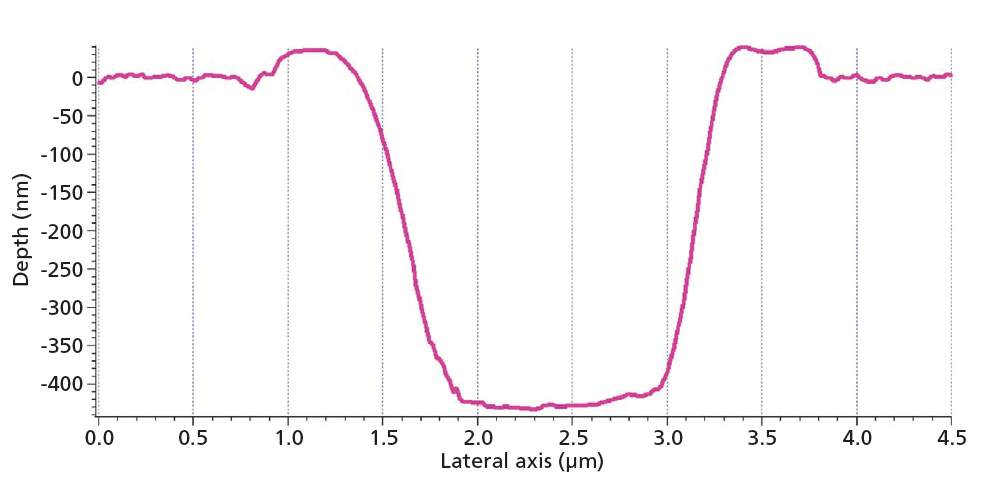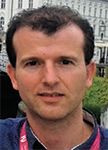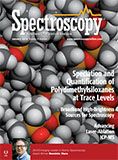Advancing Laser-Ablation ICP-MS
Jorge Pisonero of the University of Oviedo studies the performance of the laser ablation process in laser ablation–inductively coupled plasma-mass spectrometry, examining aspects such as the morphology of the craters created during sampling and the role of laser fluence. He also studies the effect of these factors in specific applications of LA-ICP-MS. He recently spoke to us about this work.
When inductively coupled plasma–mass spectrometry (lCP-MS) is combined with laser ablation in LA-ICP-MS, it becomes possible to conduct fast direct sampling of solid samples without the need for digestion. To advance the technique, Jorge Pisonero of the University of Oviedo in Spain studies the performance of the laser ablation process, examining aspects such as the shape and morphology of the craters created during the laser-ablation sampling process, the sampling distance, and laser fluence. He also studies the effect of these factors in specific applications, such as the analysis of nanoparticles in single-cells and depth profiling of photovoltaic devices. He recently spoke to us about this work.
You recently conducted a study on the use of LA-ICP-MS to measure the elemental distribution in single cells (1). First, why is a new technique needed for this type of analysis?
I believe that LA-ICP-MS is a promising methodology to investigate the distribution of nanoparticles (NPs) and quantum dots (QDs)-in particular, those related to nonluminescent compounds-in single cells, which will be of great interest in the near future for nano-toxicology and medical applications.
In your study, you used a LA-ICP-MS system that included a laser-ablation chamber with an ultrafast wash-out cycle. How does the speed of this type of chamber compare to that of traditional laser-ablation chambers? What benefits does an ultrafast washout feature provide? Are there any drawbacks to using an ultrafast washout cycle?
In the last five years, several new ultrafast wash-out ablation cells have been designed, constructed, and evaluated, providing a washout time of a few ms, which is about 100 times faster than that obtained in conventional ablation cells. These ultrafast wash-out ablation cells avoid aerosol mixing, even when using high laser repetition rate (>100 Hz) and high translational speed (>50 µm/s), providing fast analysis with high lateral resolution and high sensitivity. For example, small laser spot sizes (<5 µm in diameter) can provide high signal-to-noise ratios. The drawback of these ablation cells is that they require a simultaneous or quasi-simultaneous ICP-mass spectrometer, such as an ICP instrument with time-of-flight MS (ICP-TOF-MS), for fast multielemental analysis with high spatial resolution.
You evaluated the role of the sampling distance (the distance between the sample surface and the inner sniffer of the ablation chamber) on the wash-out time for the LA-ICP-MS ion signal. What did you find?
We observed that the sampling distance is a critical parameter to achieve a proper fast wash-out time (that is, fast extraction of the aerosol from the ablation site to the ICP). I believe that new versions of these ablation cells will include advanced methods to automatically control and adjust this parameter.
You evaluated the shape and morphology of the laser-induced craters at different laser repetition rates. How did you conduct this part of the study? What did you learn from this part of the study? (Did it help you optimize your laser ablation conditions?)
Making use of atomic force microscopy (AFM), we evaluated the shape and morphology of the laser-induced craters at different laser operating conditions (different spot size, energies, laser repetition rates). We noticed that nominal crater diameters do not always agree with the measured crater diameters. For instance, the crater spot size becomes bigger than nominal value, at increasing energy per laser pulse (>50%). Additionally, we observed that the smallest craters had a "conical shape", with a diameter of 2 µm at the surface, and a diameter of about 1 µm at the bottom. Figure 1 shows an example of a crater profile (depth measured in nm, lateral axis measured in µm). Laser ablation conditions were optimized to achieve the smallest craters with a defined "round" shape.

Figure 1: Example of a laser-induced crater profile.
When you used your method to measure the elemental distribution of cells, what did you find?
From this preliminary evaluation, we observed that NPs and QDs do not enter the nucleus of the cell, or they do it in a much lower proportion, compared to their efficiency for entering the cell cytosol.
For this study, you used a sector-field ICP-MS instrument. Why is a sector-field instrument the best choice for a study of this type?
A sector field ICP-MS instrument might not be the best choice for fast multi-elemental analysis of single cells, but it is a good choice for mono-elemental analysis, because of its higher sensitivity performance compared, for instance, to an ICP-TOF-MS instrument.
What are your next steps in this area of your work?
We need to improve the quantification methods to obtain accurate and precise concentrations values of NPs and QDs in cells. This is a challenging task because of the lack of matrix-matched reference materials.
In an earlier study, you evaluated the use of LA-ICP-MS for depth-resolved analysis of photovoltaic devices (2). What can LA-ICP-MS offer for this type of analysis that other techniques cannot?
LA-ICP-MS might be able to provide fast and highly spatially resolved analysis, combining high lateral and in-depth resolution. Moreover, with LA-ICP-MS, analysis can be carried out using atmospheric pressure conditions, without the requirements of a vacuum-compatible sample. In this context, the technique can provide high sample throughput. On the other hand, depth resolution in LA-ICP-MS is limited by the minimum penetration depth per laser pulse, which might be in the order of tens of nanometers, and by the use of flat laser beams. Therefore, this technique does not compete with other reference techniques for depth profiling such as glow discharge (GD) with optical emission spectroscopy (OES) or TOF-MS (GD-OES or GD-TOF-MS), secondary ion mass spectrometry (SIMS), atomic emission spectroscopy (AES), or X-ray photoelectron spectroscopy (XPS). Rather, LA-ICP-MS complements those techniques.
You also studied the influence of laser fluence on the ablation process. What is laser fluence, and what did you find?
Laser fluence is the amount of laser energy that is applied per unit of ablated area. It is usually expressed as Joules/cm2 (J/cm2). It is known that there is a logarithmic behavior of laser-induced crater depth and applied fluence. We also measured a minimum penetration rate of 50 nm per laser pulse when using the minimum fluence available in our laser ablation unit (1 J/cm2).
You examined the shape and morphology of the laser-induced craters. What did you find?
Crater shape and morphology are related to laser properties (such as beam profile, laser wavelength, laser energy, laser pulse duration) and to optical and thermal properties of the material. In this work, we observed that laser-induced roughness was dependent on the matrix composition of the different layers of the cadmium telluride (CdTe) photovoltaics (PV), abbreviated as CdTe PV devices.
You also optimized the laser repetition rate. Why was such optimization important?
Low laser frequency results in minimum aerosol mixing (if conventional ablation cells are employed), improving the depth resolution for in-depth profile analysis.
What did your results show about the suitability of this technique for this type of analysis?
The results showed that it is possible to obtain qualitative depth profiles of CdTe PV devices in a fast and precise way, which could be of great interest for quality control applications.
In this study, you used a LA-ICP-MS system equipped a flat-top beam argon fluoride (ArF) excimer laser. How is that system different from other LA-ICP-MS systems? Could this work be done without this specialized instrument?
The use of flat-top beam lasers results in a more homogenous ablation process, reducing the aerosol mixing from different layers of the coated material. Depth profiling with a Gaussian beam profile will probably degrade the depth resolution. Nevertheless, femtosecond laser ablation units have shown a great potential for depth profiling of conductive materials, even using Gaussian beams, because of a significant reduction of the thermal effects during the ablation process.
References
(1) J. Pisonero, D. Bouzas-Ramos, H. Traub, B. Cappella, C. álvarez-Llamas, S. Richter, J.C. Mayo, J.M. Costa-Fernández, N. Bordela, and N. Jakubowski, J. Anal. At. Spectrom. Advance Article (2018). doi: 10.1039/c8ja00096d
(2) Gutiérrez-González, C. González-Gago, J. Pisonero, N. Tibbetts, A. Menéndez, M. Véleza, and N. Bordel, J. Anal. At. Spectrom. 30, 191–197 (2015). doi: 10.1039/c4ja00196f
Laura Bush is the editorial director of LCGC North America and Spectroscopy. Direct correspondence about this article to laura.bush@ubm.com
Jorge Pisonero, PhD

Jorge Pisonero, PhD, has been an associate professor of physics since 2012 at University of Oviedo, in Spain, from which he obtained his PhD (in November 2004) working on glow discharge spectroscopy. After his PhD, he was awarded a two-year Marie Curie Intra-European Fellowship for a postdoctoral stay at ETH (Switzerland) to work on laser ablation-based techniques. Pisonero then received a prestigious "Ramon and Cajal" research contract and went back to University of Oviedo. There, in collaboration with Dr. Nerea Bordel, he established the Laser and Plasma Spectroscopy Research Group (www.unioviedo.es/gelp). His current research interests are focused on fundamentals and applications of atmospheric and low-pressure glow discharge spectroscopies, laser-induced breakdown spectroscopy (LIBS) and LA-ICP-MS. Pisonero is an author or co-author of more than 70 scientific articles and several book chapters, and has been recognized with several awards, including the Masao Horiba Award in 2009, 2011 Nobel Researcher in Applied Physics award (Spanish Royal Society of Physics), and the 2018 Winter Conference Young Scientist Award in Plasma Spectrochemistry.

Investigating ANFO Lattice Vibrations After Detonation with Raman and XRD
February 28th 2025Spectroscopy recently sat down with Dr. Geraldine Monjardez and two of her coauthors, Dr. Christopher Zall and Dr. Jared Estevanes, to discuss their most recent study, which examined the crystal structure of ammonium nitrate (AN) following exposure to explosive events.
Distinguishing Horsetails Using NIR and Predictive Modeling
February 3rd 2025Spectroscopy sat down with Knut Baumann of the University of Technology Braunschweig to discuss his latest research examining the classification of two closely related horsetail species, Equisetum arvense (field horsetail) and Equisetum palustre (marsh horsetail), using near-infrared spectroscopy (NIR).
An Inside Look at the Fundamentals and Principles of Two-Dimensional Correlation Spectroscopy
January 17th 2025Spectroscopy recently sat down with Isao Noda of the University of Delaware and Young Mee Jung of Kangwon National University to talk about the principles of two-dimensional correlation spectroscopy (2D-COS) and its key applications.
Measuring Microplastics in Remote and Pristine Environments
December 12th 2024Aleksandra "Sasha" Karapetrova and Win Cowger discuss their research using µ-FTIR spectroscopy and Open Specy software to investigate microplastic deposits in remote snow areas, shedding light on the long-range transport of microplastics.
The Fundamental Role of Advanced Hyphenated Techniques in Lithium-Ion Battery Research
December 4th 2024Spectroscopy spoke with Uwe Karst, a full professor at the University of Münster in the Institute of Inorganic and Analytical Chemistry, to discuss his research on hyphenated analytical techniques in battery research.